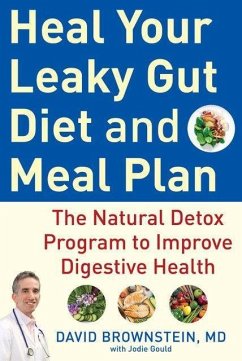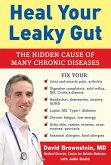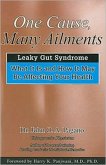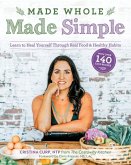David Brownstein
Heal Your Leaky Gut Diet and Food Plan
A 4-Week Detox Program to Improve Digestive Health
22,99 €
inkl. MwSt.
Versandfertig in 2-4 Wochen
David Brownstein
Heal Your Leaky Gut Diet and Food Plan
A 4-Week Detox Program to Improve Digestive Health
- Gebundenes Buch
- Merkliste
- Auf die Merkliste
- Bewerten Bewerten
- Teilen
- Produkt teilen
- Produkterinnerung
- Produkterinnerung
The companion book to Dr. David Brownstein's Heal Your Leaky Gut: The Hidden Cause of Many Chronic Diseases. Award-winning physician Dr. David Brownstein delves further into the mind-gut connection to provide a step-by-step plan to help put his findings into action with HEAL YOUR LEAKY GUT DIET AND MEAL PLAN. The gut-the gastrointestinal system-is designed to absorb nutrients that support our bodies and help us make energy, and get rid of things that we don't need or are toxic. But what happens when the system breaks down? Leaky gut syndrome (LGS) occurs when the lining of the small…mehr
Andere Kunden interessierten sich auch für
![Heal Your Leaky Gut: The Hidden Cause of Many Chronic Diseases Heal Your Leaky Gut: The Hidden Cause of Many Chronic Diseases]() Dr. David BrownsteinHeal Your Leaky Gut: The Hidden Cause of Many Chronic Diseases24,99 €
Dr. David BrownsteinHeal Your Leaky Gut: The Hidden Cause of Many Chronic Diseases24,99 €![One Cause, Many Ailments: The Leaky Gut Syndrome: What It Is and How It May Be Affecting Your Health One Cause, Many Ailments: The Leaky Gut Syndrome: What It Is and How It May Be Affecting Your Health]() John PaganoOne Cause, Many Ailments: The Leaky Gut Syndrome: What It Is and How It May Be Affecting Your Health20,99 €
John PaganoOne Cause, Many Ailments: The Leaky Gut Syndrome: What It Is and How It May Be Affecting Your Health20,99 €![Toxic: Heal Your Body from Mold Toxicity, Lyme Disease, Multiple Chemical Sensitivities, and Chronic Environmental Illness Toxic: Heal Your Body from Mold Toxicity, Lyme Disease, Multiple Chemical Sensitivities, and Chronic Environmental Illness]() Neil NathanToxic: Heal Your Body from Mold Toxicity, Lyme Disease, Multiple Chemical Sensitivities, and Chronic Environmental Illness31,99 €
Neil NathanToxic: Heal Your Body from Mold Toxicity, Lyme Disease, Multiple Chemical Sensitivities, and Chronic Environmental Illness31,99 €![Heal Your Gut Heal Your Gut]() Lee HolmesHeal Your Gut18,99 €
Lee HolmesHeal Your Gut18,99 €![The Heal Your Gut Cookbook The Heal Your Gut Cookbook]() Hilary BoyntonThe Heal Your Gut Cookbook26,99 €
Hilary BoyntonThe Heal Your Gut Cookbook26,99 €![Made Whole Made Simple: Learn to Heal Yourself Through Real Food & Healthy Habits Made Whole Made Simple: Learn to Heal Yourself Through Real Food & Healthy Habits]() Cristina CurpMade Whole Made Simple: Learn to Heal Yourself Through Real Food & Healthy Habits37,99 €
Cristina CurpMade Whole Made Simple: Learn to Heal Yourself Through Real Food & Healthy Habits37,99 €![The Longevity Book The Longevity Book]() Cameron DiazThe Longevity Book20,99 €
Cameron DiazThe Longevity Book20,99 €-
-
-
The companion book to Dr. David Brownstein's Heal Your Leaky Gut: The Hidden Cause of Many Chronic Diseases. Award-winning physician Dr. David Brownstein delves further into the mind-gut connection to provide a step-by-step plan to help put his findings into action with HEAL YOUR LEAKY GUT DIET AND MEAL PLAN. The gut-the gastrointestinal system-is designed to absorb nutrients that support our bodies and help us make energy, and get rid of things that we don't need or are toxic. But what happens when the system breaks down? Leaky gut syndrome (LGS) occurs when the lining of the small intestine is damaged, allowing foreign compounds to escape into your bloodstream, which weakens your immune system and triggers autoimmune reactions. Leaky gut syndrome (LGS) not only impacts your digestive system, it can also lead to numerous chronic conditions including allergies, arthritis, depression, anxiety, eczema, lupus, multiple sclerosis, Type 1 diabetes, and chronic fatigue. The good news is changing what you eat and drink is one of the best strategies for getting your body back on track. Dr. David Brownstein outlines simple steps you can take to change your diet and get on the path to better health:Eliminate "Gut Guzzlers" (the foods and beverages that make you sick)Incorporate more "Good Gut" foods, herbs, and nutrients that provide energyFood shopping and pantry organization tipsSeven-day meal plan to help you get startedMeal prep shortcuts to save time and keep you on trackShopping lists and what to keep on hand in your pantryDelicious, nutritious, and easy-to-prepare recipesSimple, easy-to-follow exercisesAnd much more!HEAL YOUR LEAKY GUT DIET AND MEAL PLAN provides a wealth of practical information to help readers lead a healthier lifestyle to pre-vent and manage leaky gut syndrome. The book includes shopping lists, nutritional information, eating plans and menus, as well as easy-to-follow, delicious recipes and exercises that anyone can follow. Your journey back to health through diet and proper nutrition can happen in just eight weeks!
Hinweis: Dieser Artikel kann nur an eine deutsche Lieferadresse ausgeliefert werden.
Hinweis: Dieser Artikel kann nur an eine deutsche Lieferadresse ausgeliefert werden.
Produktdetails
- Produktdetails
- Verlag: Humanix Books
- Seitenzahl: 200
- Erscheinungstermin: 8. Juni 2023
- Englisch
- Abmessung: 231mm x 155mm x 18mm
- Gewicht: 408g
- ISBN-13: 9781630062217
- ISBN-10: 1630062219
- Artikelnr.: 62313300
- Verlag: Humanix Books
- Seitenzahl: 200
- Erscheinungstermin: 8. Juni 2023
- Englisch
- Abmessung: 231mm x 155mm x 18mm
- Gewicht: 408g
- ISBN-13: 9781630062217
- ISBN-10: 1630062219
- Artikelnr.: 62313300
DAVID BROWNSTEIN, M.D. is a Board-Certified family physician and is one of the foremost practitioners of holistic medicine. He is the Medical Director of the Center for Holistic Medicine in West Bloomfield, MI. Dr. Brownstein has lectured internationally to physicians and others about his success in using natural hormones and nutritional therapies in his practice. He is a graduate of the University of Michigan and Wayne State University School of Medicine. Dr. Brownstein is a member of the American Academy of Family Physicians and the American College for the Advancement in Medicine. Dr. Brownstein has received two prestigious awards by his colleagues. The first was given by the American College for the Advancement in Medicine at the 2005 annual meeting. The award was the Norman E. Clarke Sr. Award for Science and Practice. The second award was given by the American Academy of Integrative Medicine at their 2005 annual meeting in Florida. This was titled, 2005 ARC Excellence Award for Distinguished Clinician for his Advancement in the Diagnosis and Treatment of Chronic Diseases. Dr. Brownstein is the father of two beautiful girls, Hailey and Jessica, and is a retired soccer coach. He lives & works in West Bloomfield, Minnesota. www.centerforholisticmedicine.com
OUTLINE for HEAL YOUR LEAKY GUT DIET AND MEAL PLAN: A 4-Week Detox Program
to Improve Digestive Health by David Brownstein, M.D. and Jodie Gould
INTRODUCTION
Dr. Brownstein will reintroduce himself to readers and explain why the
Leaky Gut Diet and Meal Plan will help heal their gut conditions. He will
lay out the promise of the book, including how the food choices, recipes
and lifestyle tips in the book will help them feel better, have more
energy, and (a bonus) make them leaner. Readers don’t have to deprive
themselves or go hungry in order to get healthy! He will also explain how
the LGD Diet and Meal Plan will include info on nutritional and hormonal
factors that are important to maintaining gut health.
CHAPTER 1: What is Leaky Gut Syndrome?
In this chapter, Dr. B will give an overview of LGS, the symptoms,
conditions it creates, and gut facts, including the gut-brain connection,
microbiome, and other factors that affect our gut). It will include new
data/studies on gut issues that have come out since the first book was
released in 2016. (e.g. A recent study published in the journal Nature
Metabolism, found that as people get older, the composition of the complex
community of microbes, known as the gut microbiome, tends to change. The
greater the change, the better it is for your health and longevity.)
CHAPTER 2: The Leaky Gut Diet and Meal Plan
This chapter will take readers through the TK-steps of the Leaky Gut
Diet/Meal Plan, a 6-week program that starts with getting rid of the “Gut
Guzzlers”-- foods and ingredients that are making them sick. Dr. B will
explain how introducing “Good Gut” foods, ingredients, and nutrients into
their diet will help them heal and get healthier. The easy-to-follow steps
in the diet and meal plan include:
Step 1: Eliminate Gut Guzzlers. The diet starts with removing all refined
foods/ingredients that deplete vital nutrients from your body. The list of
Gut Guzzlers includes refined sugar, carbohydrates, flour, hydrogenated
oils, and salt.
Step 2: Safe Substitutes. Replace with Good Gut foods, including natural
sweeteners (agave nectar, raw honey, molasas); Celtic sea salt, nutritious
nuts for chips (e.g., almonds, Brazil nuts); whole-grain breads instead of
white bread (sourdough, sprouted); and steel cut oatmeal for sugary
cereals.
Step 3: Stop the Pop/Lose the Lactose. An essential step in the LGD is
avoiding soda, juice, and milk. Dr. B will explain why.
Step 4: Hydrate. One of the key (and free) elements of the Leaky Gut Diet
is drinking more water. This step show readers how to calculate their daily
water intake.
Step 5: Correct Hormonal Imbalances. If these recommended dietary changes
are not showing an improvement, check with a doctor for hormonal
imbalances, such as low thyroid, estrogen, testosterone, or cortisol levels
to see if one of these is at the root of your gut issues. A hormonal
treatment plan will help speed up your recovery process (along with
following the diet plan).
Step 6: Vitamins and supplements (The Pros of Pro- and Prebiotics)
Step 7: Eat Slow Meals. The benefits of a whole food, plant-based diets
filled with fresh fruits and vegetables versus highly processed, fast food.
Step 8: Move. This step can be done from day one. The book will include
motivational tips for exercise haters to make movement a regular part of
their lives.
CHAPTER 3: Organizing Your Pantry and Kitchen
Any good meal plan begins with stocking the pantry. This chapter will help
readers organize their kitchen cabinets by food groups that include the
ingredients they will need to make the delicious, gut-healing recipes in
the book. (e.g., poultry, pish, ped meat, produce, oils, nuts, spices,
etc). It will also include a shopping list for food staples and fresh foods
to buy daily/weekly, and what should be organic only.
CHAPTER 4: Get Motivated (Go with Your Gut!)
Motivational tips for starting and staying on the diet/plan. Also, what to
do if readers fall off the wagon.
CHAPTER 5: Recipes for Breakfast, Lunch, Dinner, Snacks & Beverages
FEATURES/TIPS/CHARTS/SIDEBARS
The Brain-Gut Connection. Dr. Brownstein will explain why readers who have
“gone with their gut” or felt “butterflies in your stomach” when nervous,
are likely getting signals from their second brain. Hidden in the walls of
the digestive system, this “brain gut connection” is revolutionizing
medicine’s understanding of the links between digestion, mood, health and
even the way you think.
Food Diary/Symptom Tracker. The book can include pages in the back for
recording meals and snacks, along with a Symptom Tracker for spotting red
flags (allergic reactions) as well as health improvements. Studies show
that keeping a food journal helps people become more aware of their choices
and can encourage them to be more mindful of not only what they are eating,
but also help identify certain triggers of unhealthy eating.
Is Yogurt Really Healthy? Depends. The Truth About Flavored Yogurt (e.g.,
sugar, corn syrup additives, over processing.)
Read the Label. How to decipher the nutrition info for calories, nutrients,
additives, etc) Should include advertising buzzwords like “natural” and
“healthy.” Also, the truth about sell-by dates.
Exercise Tips. This should be for all levels, from exercise haters, to
weekend warriors and fitness fanatics.
Eating Out. A guide to ordering when going to restaurants. (“Cheat Sheets”
with Do’s and Don’ts that readers can rip out of the book and take with
them.) Major tip: Ask the server how your dish is made.
Beverages. Tips for kicking the juice and soda habit. Eat whole fruits
instead. (More sugar in apple juice than in cola.)
Size Matters. Tips on portion size. (e.g., palm of hand, use smaller
plates, avoid all-you-can buffets.)
Chew on This. Tips on taking small bites, eating slowly and the importance
of fully chewing, avoid distractions like phones and TV while eating.
The Diet Combo Platter. Dr. Brownstein will weigh in on the most popular
diets such as Paleo, Keto, Meditarranean and intermittent fasting, and what
parts (if any) can be incorporated into the LGD.
Suppliers of Specialty Foods. Information on suppliers of specialty foods.
Glycemic Index Chart
The Skinny on Fats. Unsaturated vs saturated. Trans fats.
Healthy and Unhealthy Cooking Oils. (Olive vs. Vegetable)
Tips for Celiac Sufferers (Gluten-Free recommendations)
to Improve Digestive Health by David Brownstein, M.D. and Jodie Gould
INTRODUCTION
Dr. Brownstein will reintroduce himself to readers and explain why the
Leaky Gut Diet and Meal Plan will help heal their gut conditions. He will
lay out the promise of the book, including how the food choices, recipes
and lifestyle tips in the book will help them feel better, have more
energy, and (a bonus) make them leaner. Readers don’t have to deprive
themselves or go hungry in order to get healthy! He will also explain how
the LGD Diet and Meal Plan will include info on nutritional and hormonal
factors that are important to maintaining gut health.
CHAPTER 1: What is Leaky Gut Syndrome?
In this chapter, Dr. B will give an overview of LGS, the symptoms,
conditions it creates, and gut facts, including the gut-brain connection,
microbiome, and other factors that affect our gut). It will include new
data/studies on gut issues that have come out since the first book was
released in 2016. (e.g. A recent study published in the journal Nature
Metabolism, found that as people get older, the composition of the complex
community of microbes, known as the gut microbiome, tends to change. The
greater the change, the better it is for your health and longevity.)
CHAPTER 2: The Leaky Gut Diet and Meal Plan
This chapter will take readers through the TK-steps of the Leaky Gut
Diet/Meal Plan, a 6-week program that starts with getting rid of the “Gut
Guzzlers”-- foods and ingredients that are making them sick. Dr. B will
explain how introducing “Good Gut” foods, ingredients, and nutrients into
their diet will help them heal and get healthier. The easy-to-follow steps
in the diet and meal plan include:
Step 1: Eliminate Gut Guzzlers. The diet starts with removing all refined
foods/ingredients that deplete vital nutrients from your body. The list of
Gut Guzzlers includes refined sugar, carbohydrates, flour, hydrogenated
oils, and salt.
Step 2: Safe Substitutes. Replace with Good Gut foods, including natural
sweeteners (agave nectar, raw honey, molasas); Celtic sea salt, nutritious
nuts for chips (e.g., almonds, Brazil nuts); whole-grain breads instead of
white bread (sourdough, sprouted); and steel cut oatmeal for sugary
cereals.
Step 3: Stop the Pop/Lose the Lactose. An essential step in the LGD is
avoiding soda, juice, and milk. Dr. B will explain why.
Step 4: Hydrate. One of the key (and free) elements of the Leaky Gut Diet
is drinking more water. This step show readers how to calculate their daily
water intake.
Step 5: Correct Hormonal Imbalances. If these recommended dietary changes
are not showing an improvement, check with a doctor for hormonal
imbalances, such as low thyroid, estrogen, testosterone, or cortisol levels
to see if one of these is at the root of your gut issues. A hormonal
treatment plan will help speed up your recovery process (along with
following the diet plan).
Step 6: Vitamins and supplements (The Pros of Pro- and Prebiotics)
Step 7: Eat Slow Meals. The benefits of a whole food, plant-based diets
filled with fresh fruits and vegetables versus highly processed, fast food.
Step 8: Move. This step can be done from day one. The book will include
motivational tips for exercise haters to make movement a regular part of
their lives.
CHAPTER 3: Organizing Your Pantry and Kitchen
Any good meal plan begins with stocking the pantry. This chapter will help
readers organize their kitchen cabinets by food groups that include the
ingredients they will need to make the delicious, gut-healing recipes in
the book. (e.g., poultry, pish, ped meat, produce, oils, nuts, spices,
etc). It will also include a shopping list for food staples and fresh foods
to buy daily/weekly, and what should be organic only.
CHAPTER 4: Get Motivated (Go with Your Gut!)
Motivational tips for starting and staying on the diet/plan. Also, what to
do if readers fall off the wagon.
CHAPTER 5: Recipes for Breakfast, Lunch, Dinner, Snacks & Beverages
FEATURES/TIPS/CHARTS/SIDEBARS
The Brain-Gut Connection. Dr. Brownstein will explain why readers who have
“gone with their gut” or felt “butterflies in your stomach” when nervous,
are likely getting signals from their second brain. Hidden in the walls of
the digestive system, this “brain gut connection” is revolutionizing
medicine’s understanding of the links between digestion, mood, health and
even the way you think.
Food Diary/Symptom Tracker. The book can include pages in the back for
recording meals and snacks, along with a Symptom Tracker for spotting red
flags (allergic reactions) as well as health improvements. Studies show
that keeping a food journal helps people become more aware of their choices
and can encourage them to be more mindful of not only what they are eating,
but also help identify certain triggers of unhealthy eating.
Is Yogurt Really Healthy? Depends. The Truth About Flavored Yogurt (e.g.,
sugar, corn syrup additives, over processing.)
Read the Label. How to decipher the nutrition info for calories, nutrients,
additives, etc) Should include advertising buzzwords like “natural” and
“healthy.” Also, the truth about sell-by dates.
Exercise Tips. This should be for all levels, from exercise haters, to
weekend warriors and fitness fanatics.
Eating Out. A guide to ordering when going to restaurants. (“Cheat Sheets”
with Do’s and Don’ts that readers can rip out of the book and take with
them.) Major tip: Ask the server how your dish is made.
Beverages. Tips for kicking the juice and soda habit. Eat whole fruits
instead. (More sugar in apple juice than in cola.)
Size Matters. Tips on portion size. (e.g., palm of hand, use smaller
plates, avoid all-you-can buffets.)
Chew on This. Tips on taking small bites, eating slowly and the importance
of fully chewing, avoid distractions like phones and TV while eating.
The Diet Combo Platter. Dr. Brownstein will weigh in on the most popular
diets such as Paleo, Keto, Meditarranean and intermittent fasting, and what
parts (if any) can be incorporated into the LGD.
Suppliers of Specialty Foods. Information on suppliers of specialty foods.
Glycemic Index Chart
The Skinny on Fats. Unsaturated vs saturated. Trans fats.
Healthy and Unhealthy Cooking Oils. (Olive vs. Vegetable)
Tips for Celiac Sufferers (Gluten-Free recommendations)
OUTLINE for HEAL YOUR LEAKY GUT DIET AND MEAL PLAN: A 4-Week Detox Program
to Improve Digestive Health by David Brownstein, M.D. and Jodie Gould
INTRODUCTION
Dr. Brownstein will reintroduce himself to readers and explain why the
Leaky Gut Diet and Meal Plan will help heal their gut conditions. He will
lay out the promise of the book, including how the food choices, recipes
and lifestyle tips in the book will help them feel better, have more
energy, and (a bonus) make them leaner. Readers don’t have to deprive
themselves or go hungry in order to get healthy! He will also explain how
the LGD Diet and Meal Plan will include info on nutritional and hormonal
factors that are important to maintaining gut health.
CHAPTER 1: What is Leaky Gut Syndrome?
In this chapter, Dr. B will give an overview of LGS, the symptoms,
conditions it creates, and gut facts, including the gut-brain connection,
microbiome, and other factors that affect our gut). It will include new
data/studies on gut issues that have come out since the first book was
released in 2016. (e.g. A recent study published in the journal Nature
Metabolism, found that as people get older, the composition of the complex
community of microbes, known as the gut microbiome, tends to change. The
greater the change, the better it is for your health and longevity.)
CHAPTER 2: The Leaky Gut Diet and Meal Plan
This chapter will take readers through the TK-steps of the Leaky Gut
Diet/Meal Plan, a 6-week program that starts with getting rid of the “Gut
Guzzlers”-- foods and ingredients that are making them sick. Dr. B will
explain how introducing “Good Gut” foods, ingredients, and nutrients into
their diet will help them heal and get healthier. The easy-to-follow steps
in the diet and meal plan include:
Step 1: Eliminate Gut Guzzlers. The diet starts with removing all refined
foods/ingredients that deplete vital nutrients from your body. The list of
Gut Guzzlers includes refined sugar, carbohydrates, flour, hydrogenated
oils, and salt.
Step 2: Safe Substitutes. Replace with Good Gut foods, including natural
sweeteners (agave nectar, raw honey, molasas); Celtic sea salt, nutritious
nuts for chips (e.g., almonds, Brazil nuts); whole-grain breads instead of
white bread (sourdough, sprouted); and steel cut oatmeal for sugary
cereals.
Step 3: Stop the Pop/Lose the Lactose. An essential step in the LGD is
avoiding soda, juice, and milk. Dr. B will explain why.
Step 4: Hydrate. One of the key (and free) elements of the Leaky Gut Diet
is drinking more water. This step show readers how to calculate their daily
water intake.
Step 5: Correct Hormonal Imbalances. If these recommended dietary changes
are not showing an improvement, check with a doctor for hormonal
imbalances, such as low thyroid, estrogen, testosterone, or cortisol levels
to see if one of these is at the root of your gut issues. A hormonal
treatment plan will help speed up your recovery process (along with
following the diet plan).
Step 6: Vitamins and supplements (The Pros of Pro- and Prebiotics)
Step 7: Eat Slow Meals. The benefits of a whole food, plant-based diets
filled with fresh fruits and vegetables versus highly processed, fast food.
Step 8: Move. This step can be done from day one. The book will include
motivational tips for exercise haters to make movement a regular part of
their lives.
CHAPTER 3: Organizing Your Pantry and Kitchen
Any good meal plan begins with stocking the pantry. This chapter will help
readers organize their kitchen cabinets by food groups that include the
ingredients they will need to make the delicious, gut-healing recipes in
the book. (e.g., poultry, pish, ped meat, produce, oils, nuts, spices,
etc). It will also include a shopping list for food staples and fresh foods
to buy daily/weekly, and what should be organic only.
CHAPTER 4: Get Motivated (Go with Your Gut!)
Motivational tips for starting and staying on the diet/plan. Also, what to
do if readers fall off the wagon.
CHAPTER 5: Recipes for Breakfast, Lunch, Dinner, Snacks & Beverages
FEATURES/TIPS/CHARTS/SIDEBARS
The Brain-Gut Connection. Dr. Brownstein will explain why readers who have
“gone with their gut” or felt “butterflies in your stomach” when nervous,
are likely getting signals from their second brain. Hidden in the walls of
the digestive system, this “brain gut connection” is revolutionizing
medicine’s understanding of the links between digestion, mood, health and
even the way you think.
Food Diary/Symptom Tracker. The book can include pages in the back for
recording meals and snacks, along with a Symptom Tracker for spotting red
flags (allergic reactions) as well as health improvements. Studies show
that keeping a food journal helps people become more aware of their choices
and can encourage them to be more mindful of not only what they are eating,
but also help identify certain triggers of unhealthy eating.
Is Yogurt Really Healthy? Depends. The Truth About Flavored Yogurt (e.g.,
sugar, corn syrup additives, over processing.)
Read the Label. How to decipher the nutrition info for calories, nutrients,
additives, etc) Should include advertising buzzwords like “natural” and
“healthy.” Also, the truth about sell-by dates.
Exercise Tips. This should be for all levels, from exercise haters, to
weekend warriors and fitness fanatics.
Eating Out. A guide to ordering when going to restaurants. (“Cheat Sheets”
with Do’s and Don’ts that readers can rip out of the book and take with
them.) Major tip: Ask the server how your dish is made.
Beverages. Tips for kicking the juice and soda habit. Eat whole fruits
instead. (More sugar in apple juice than in cola.)
Size Matters. Tips on portion size. (e.g., palm of hand, use smaller
plates, avoid all-you-can buffets.)
Chew on This. Tips on taking small bites, eating slowly and the importance
of fully chewing, avoid distractions like phones and TV while eating.
The Diet Combo Platter. Dr. Brownstein will weigh in on the most popular
diets such as Paleo, Keto, Meditarranean and intermittent fasting, and what
parts (if any) can be incorporated into the LGD.
Suppliers of Specialty Foods. Information on suppliers of specialty foods.
Glycemic Index Chart
The Skinny on Fats. Unsaturated vs saturated. Trans fats.
Healthy and Unhealthy Cooking Oils. (Olive vs. Vegetable)
Tips for Celiac Sufferers (Gluten-Free recommendations)
to Improve Digestive Health by David Brownstein, M.D. and Jodie Gould
INTRODUCTION
Dr. Brownstein will reintroduce himself to readers and explain why the
Leaky Gut Diet and Meal Plan will help heal their gut conditions. He will
lay out the promise of the book, including how the food choices, recipes
and lifestyle tips in the book will help them feel better, have more
energy, and (a bonus) make them leaner. Readers don’t have to deprive
themselves or go hungry in order to get healthy! He will also explain how
the LGD Diet and Meal Plan will include info on nutritional and hormonal
factors that are important to maintaining gut health.
CHAPTER 1: What is Leaky Gut Syndrome?
In this chapter, Dr. B will give an overview of LGS, the symptoms,
conditions it creates, and gut facts, including the gut-brain connection,
microbiome, and other factors that affect our gut). It will include new
data/studies on gut issues that have come out since the first book was
released in 2016. (e.g. A recent study published in the journal Nature
Metabolism, found that as people get older, the composition of the complex
community of microbes, known as the gut microbiome, tends to change. The
greater the change, the better it is for your health and longevity.)
CHAPTER 2: The Leaky Gut Diet and Meal Plan
This chapter will take readers through the TK-steps of the Leaky Gut
Diet/Meal Plan, a 6-week program that starts with getting rid of the “Gut
Guzzlers”-- foods and ingredients that are making them sick. Dr. B will
explain how introducing “Good Gut” foods, ingredients, and nutrients into
their diet will help them heal and get healthier. The easy-to-follow steps
in the diet and meal plan include:
Step 1: Eliminate Gut Guzzlers. The diet starts with removing all refined
foods/ingredients that deplete vital nutrients from your body. The list of
Gut Guzzlers includes refined sugar, carbohydrates, flour, hydrogenated
oils, and salt.
Step 2: Safe Substitutes. Replace with Good Gut foods, including natural
sweeteners (agave nectar, raw honey, molasas); Celtic sea salt, nutritious
nuts for chips (e.g., almonds, Brazil nuts); whole-grain breads instead of
white bread (sourdough, sprouted); and steel cut oatmeal for sugary
cereals.
Step 3: Stop the Pop/Lose the Lactose. An essential step in the LGD is
avoiding soda, juice, and milk. Dr. B will explain why.
Step 4: Hydrate. One of the key (and free) elements of the Leaky Gut Diet
is drinking more water. This step show readers how to calculate their daily
water intake.
Step 5: Correct Hormonal Imbalances. If these recommended dietary changes
are not showing an improvement, check with a doctor for hormonal
imbalances, such as low thyroid, estrogen, testosterone, or cortisol levels
to see if one of these is at the root of your gut issues. A hormonal
treatment plan will help speed up your recovery process (along with
following the diet plan).
Step 6: Vitamins and supplements (The Pros of Pro- and Prebiotics)
Step 7: Eat Slow Meals. The benefits of a whole food, plant-based diets
filled with fresh fruits and vegetables versus highly processed, fast food.
Step 8: Move. This step can be done from day one. The book will include
motivational tips for exercise haters to make movement a regular part of
their lives.
CHAPTER 3: Organizing Your Pantry and Kitchen
Any good meal plan begins with stocking the pantry. This chapter will help
readers organize their kitchen cabinets by food groups that include the
ingredients they will need to make the delicious, gut-healing recipes in
the book. (e.g., poultry, pish, ped meat, produce, oils, nuts, spices,
etc). It will also include a shopping list for food staples and fresh foods
to buy daily/weekly, and what should be organic only.
CHAPTER 4: Get Motivated (Go with Your Gut!)
Motivational tips for starting and staying on the diet/plan. Also, what to
do if readers fall off the wagon.
CHAPTER 5: Recipes for Breakfast, Lunch, Dinner, Snacks & Beverages
FEATURES/TIPS/CHARTS/SIDEBARS
The Brain-Gut Connection. Dr. Brownstein will explain why readers who have
“gone with their gut” or felt “butterflies in your stomach” when nervous,
are likely getting signals from their second brain. Hidden in the walls of
the digestive system, this “brain gut connection” is revolutionizing
medicine’s understanding of the links between digestion, mood, health and
even the way you think.
Food Diary/Symptom Tracker. The book can include pages in the back for
recording meals and snacks, along with a Symptom Tracker for spotting red
flags (allergic reactions) as well as health improvements. Studies show
that keeping a food journal helps people become more aware of their choices
and can encourage them to be more mindful of not only what they are eating,
but also help identify certain triggers of unhealthy eating.
Is Yogurt Really Healthy? Depends. The Truth About Flavored Yogurt (e.g.,
sugar, corn syrup additives, over processing.)
Read the Label. How to decipher the nutrition info for calories, nutrients,
additives, etc) Should include advertising buzzwords like “natural” and
“healthy.” Also, the truth about sell-by dates.
Exercise Tips. This should be for all levels, from exercise haters, to
weekend warriors and fitness fanatics.
Eating Out. A guide to ordering when going to restaurants. (“Cheat Sheets”
with Do’s and Don’ts that readers can rip out of the book and take with
them.) Major tip: Ask the server how your dish is made.
Beverages. Tips for kicking the juice and soda habit. Eat whole fruits
instead. (More sugar in apple juice than in cola.)
Size Matters. Tips on portion size. (e.g., palm of hand, use smaller
plates, avoid all-you-can buffets.)
Chew on This. Tips on taking small bites, eating slowly and the importance
of fully chewing, avoid distractions like phones and TV while eating.
The Diet Combo Platter. Dr. Brownstein will weigh in on the most popular
diets such as Paleo, Keto, Meditarranean and intermittent fasting, and what
parts (if any) can be incorporated into the LGD.
Suppliers of Specialty Foods. Information on suppliers of specialty foods.
Glycemic Index Chart
The Skinny on Fats. Unsaturated vs saturated. Trans fats.
Healthy and Unhealthy Cooking Oils. (Olive vs. Vegetable)
Tips for Celiac Sufferers (Gluten-Free recommendations)







